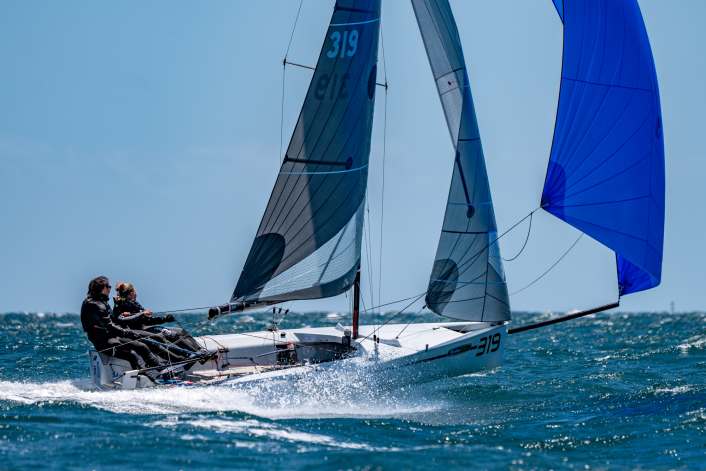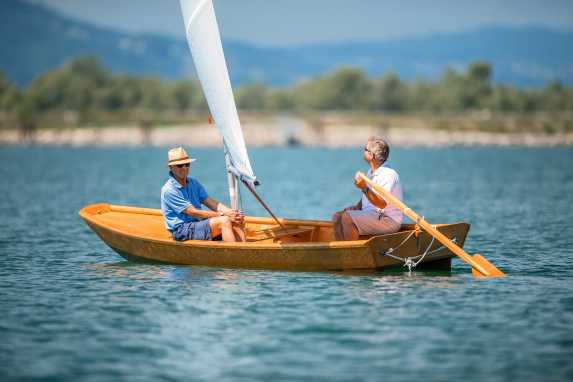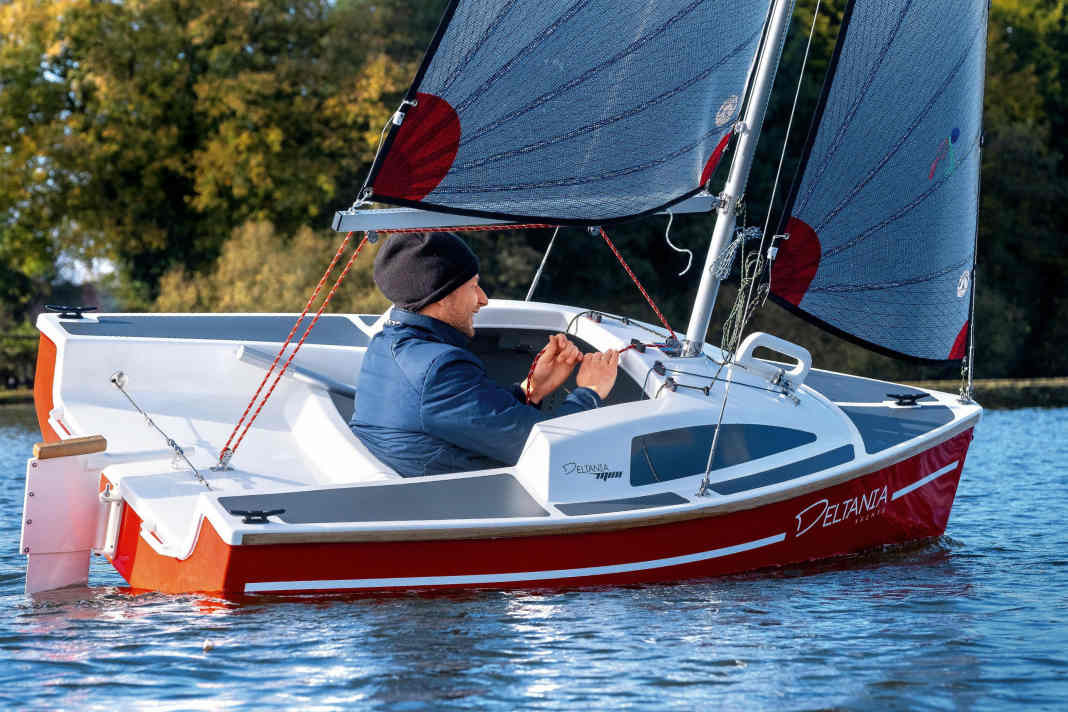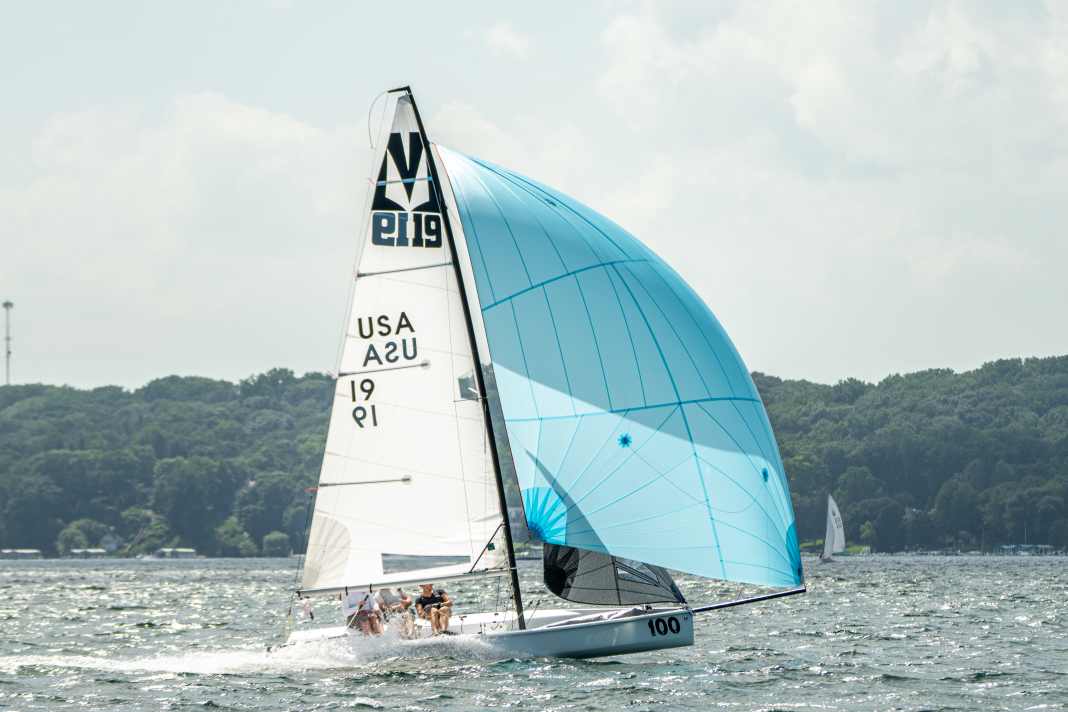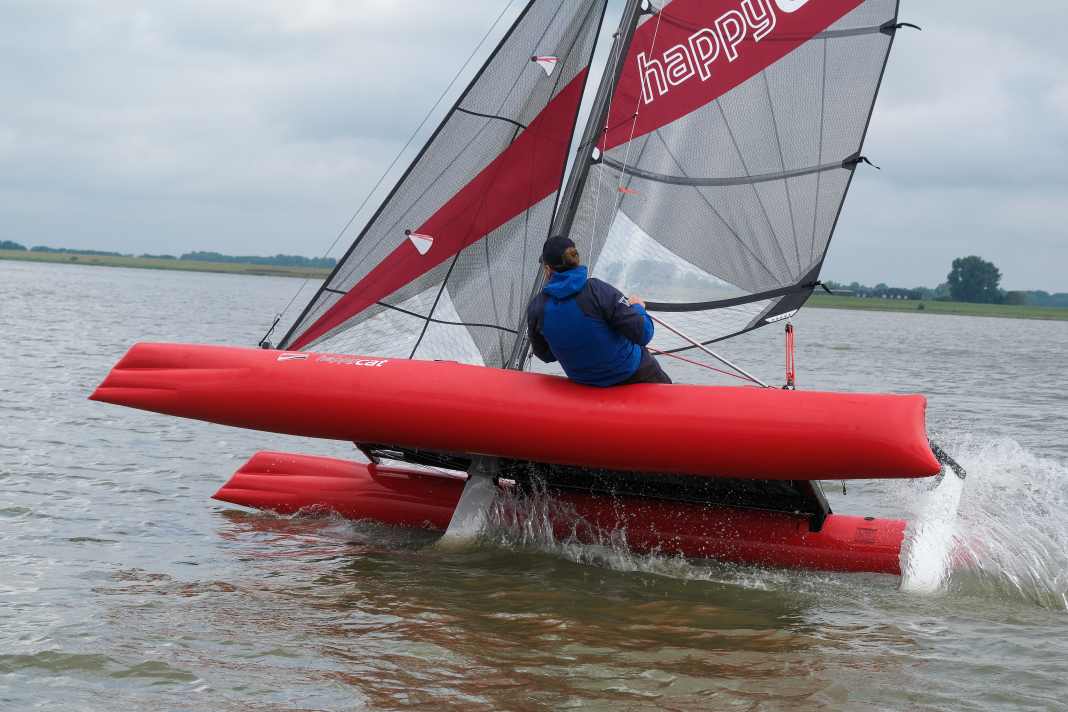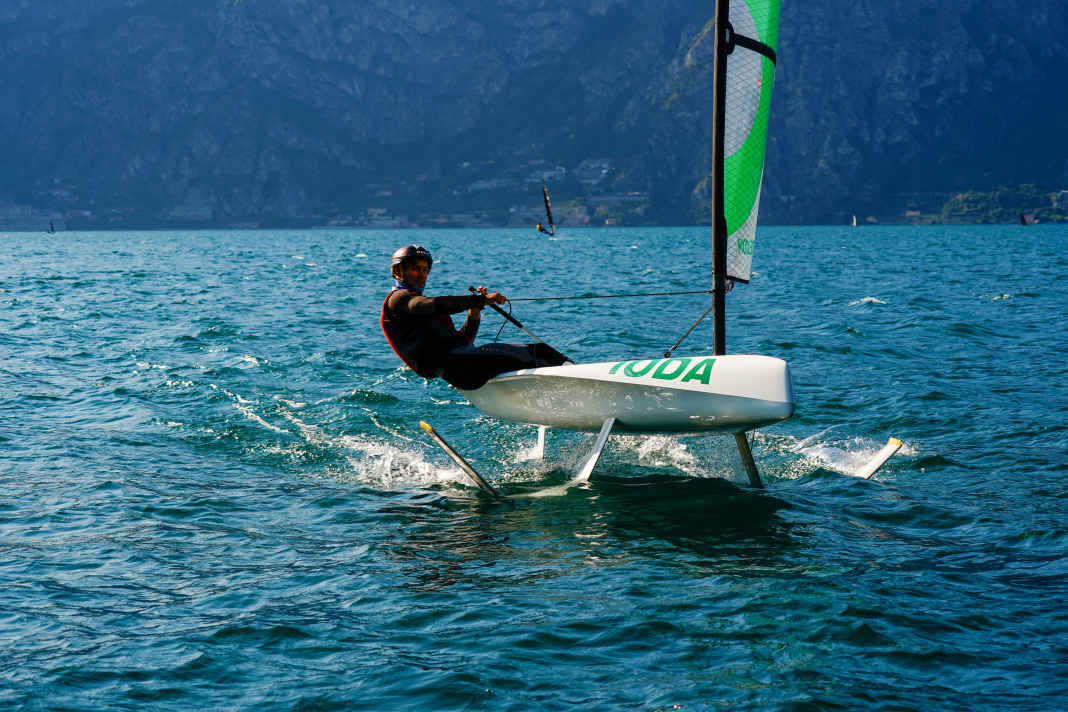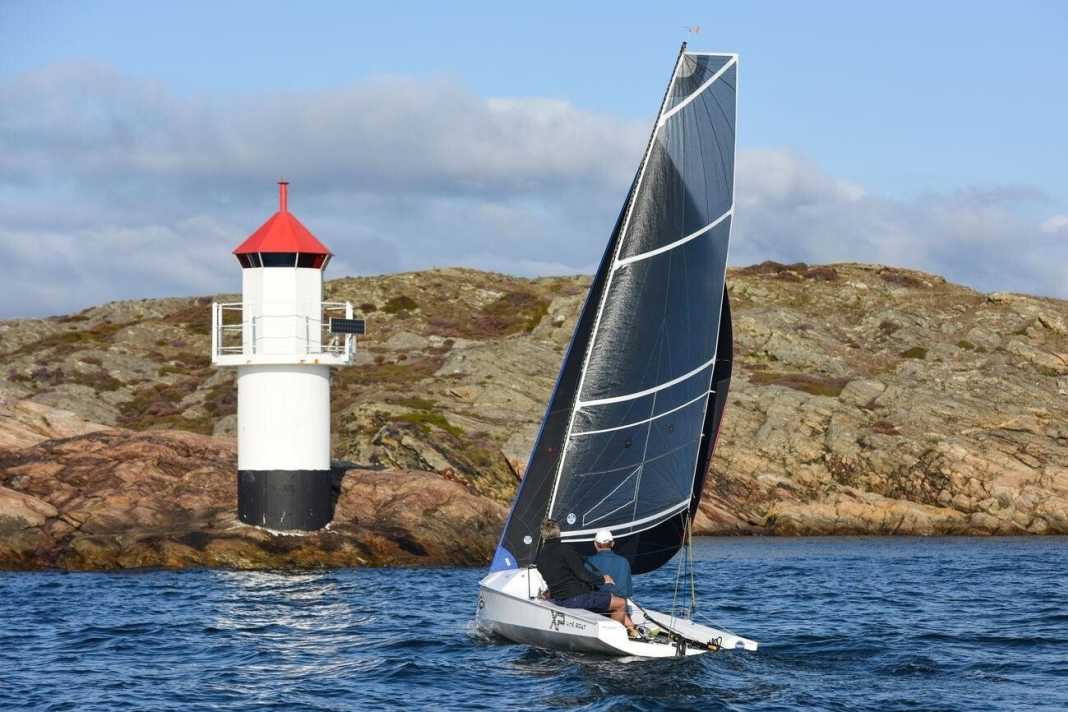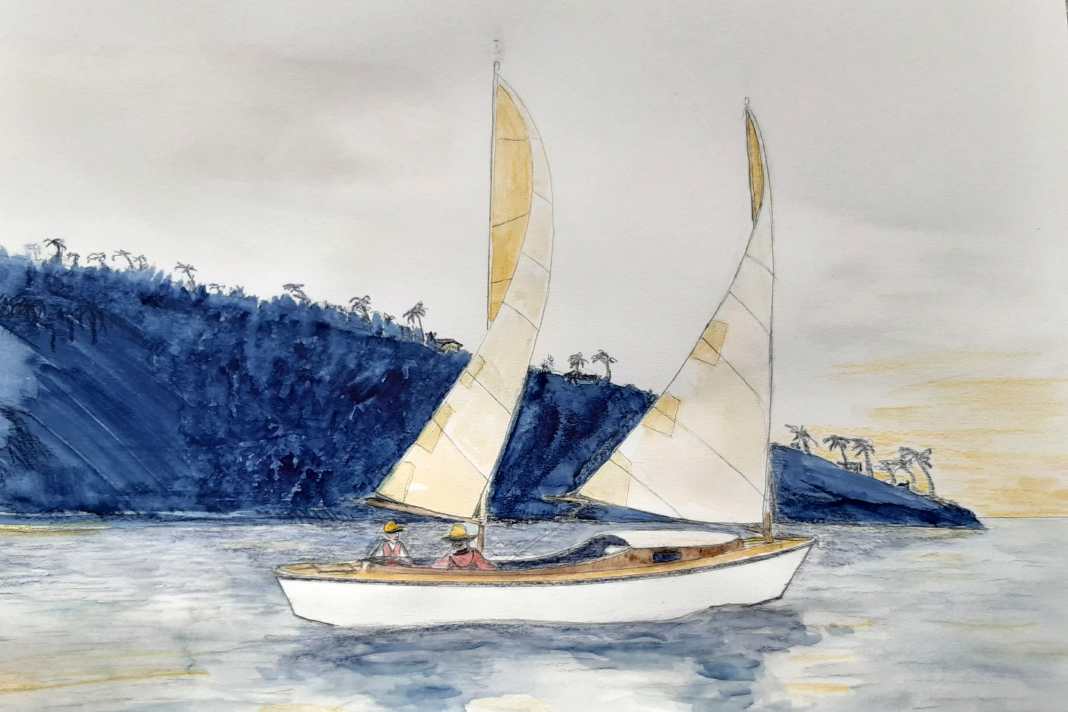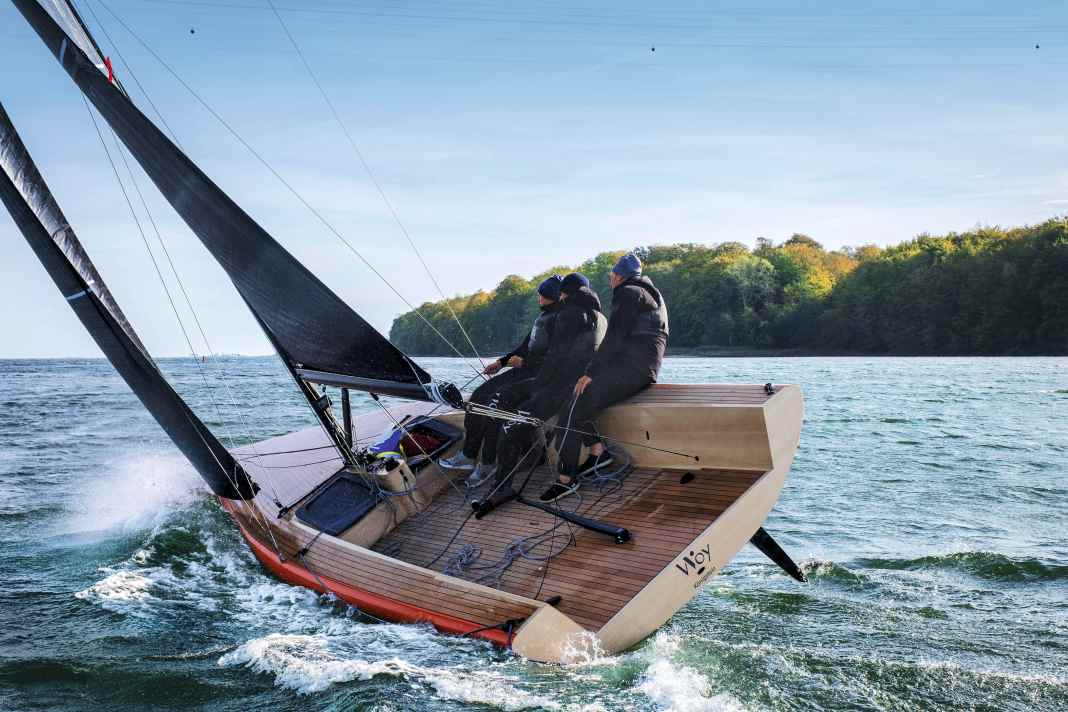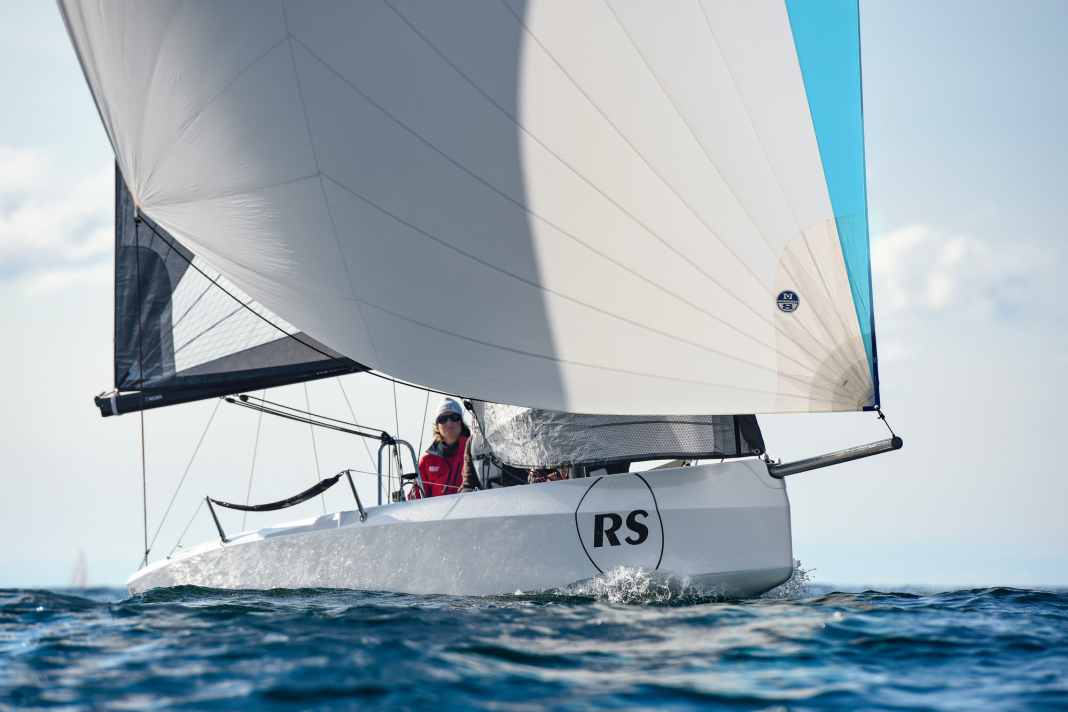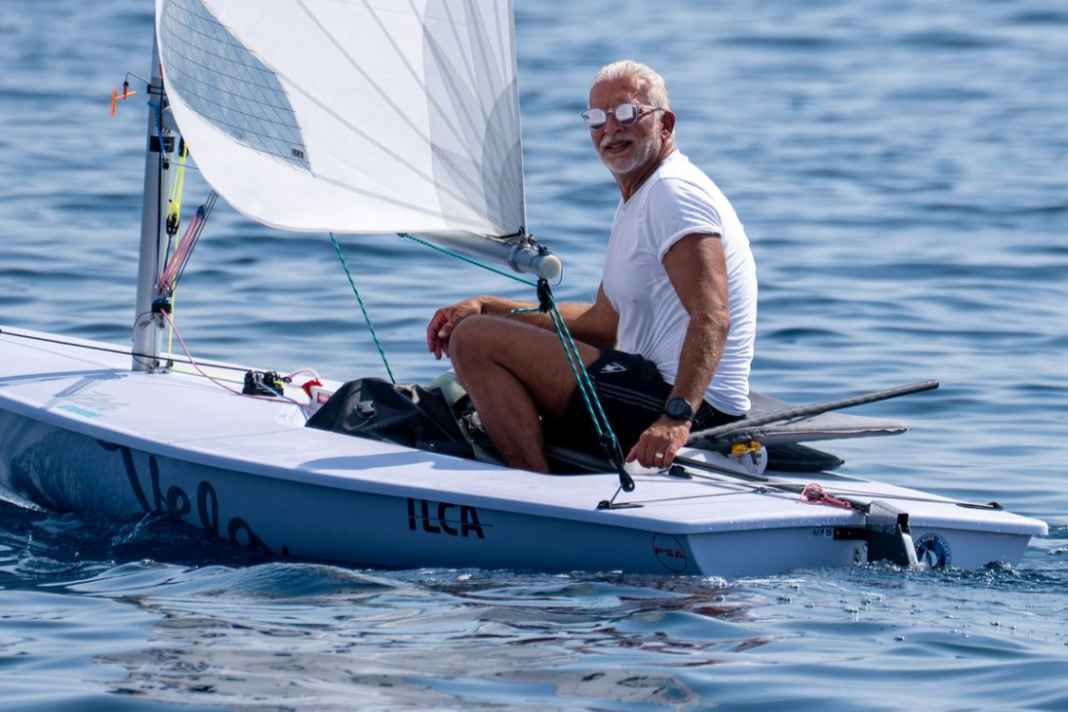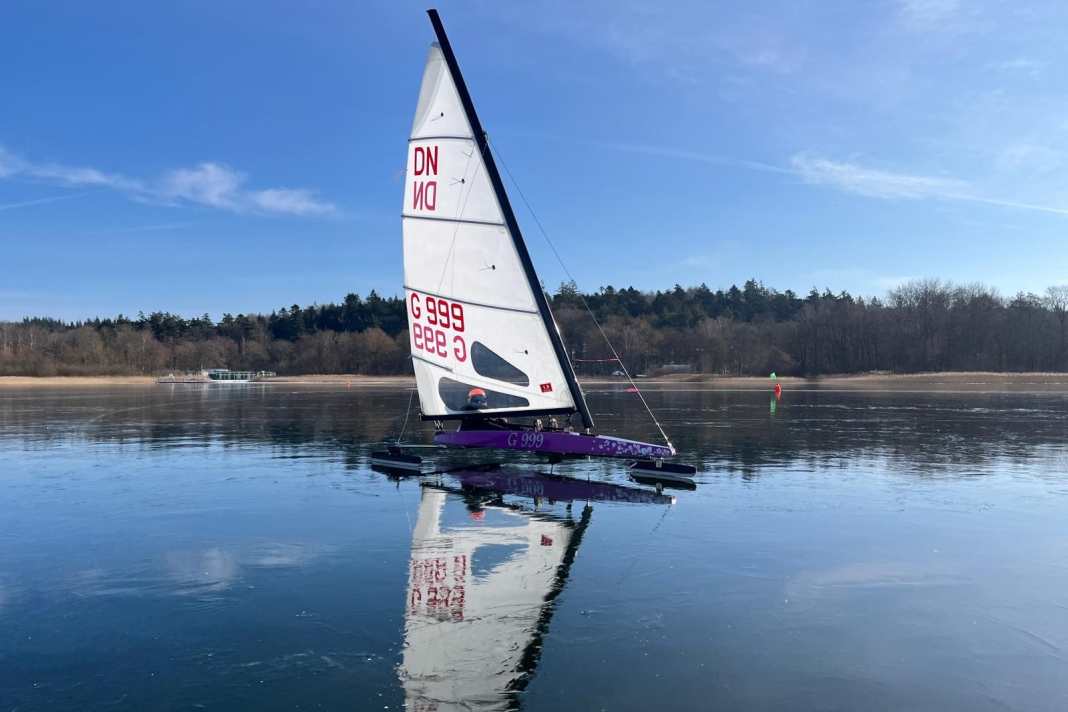Dinghies - sailing fun in its purest form
Dinghies are small and light sailing boats that Regattas and sporting competitions. However, sailing dinghies and dinghy cruisers are also widely used for leisure and are known for their high fun factor. They also offer the opportunity to keep physically fit and train your stamina.
Dinghies- Small but nice
The term "dinghy" comes from Norwegian. There, small, round-bottomed boats without a keel are called "jöll". And in fact, a dinghy is not a keelboat, but a centreboard. This is also the main distinguishing feature compared to yachts, for example. These normally have a ballast keel, which increases the righting moment. A centreboard, on the other hand, is light and has no ballast.
Centreboard boats generally have their centre of gravity above the waterline and are therefore not capsize-proof. They derive their stability from their shape, also known as dimensional stability. The wider and flatter the shape, the greater the dimensional stability. Dimensional stability is created by the water pressure acting on the flat hull. It also provides a certain righting moment, although this is less than for boats with ballast. This means that most dinghies will right themselves again up to a slight inclination, known as heeling, without the help of the crew. However, this only applies in light winds and when the wind pressure on the dinghy increases after a light gust. Sail decreases.
If there are stronger winds or you have to react to stronger gusts, the body weight of the skipper and crew comes into play. To counteract the lean and possible capsize, they have to shift their body weight. Upwind to the outside. This creates a kind of counterweight to the wind pressure in the sail.
Not all dinghies are the same- the different types
Dinghies are divided into different categories and dinghy classes. This applies not only to the hull or hull shape and the number and type of sails, but also to the way in which the dinghy is used.
Classic sailing with travelling dinghies, for example, is different from racing dinghies, which are designed as a boat type for regattas and races.
Among other things, a distinction is made between
- Classic dinghies
- Modern dinghies
- Racing dinghies
- Travelling dinghies
- Dinghy cruiser
- Car roof dinghies
- Skiffs
- Foiling dinghies
A distinction is also made according to the number of crew members. There are dinghies that are sailed alone, called one-man dinghies or single-handed dinghies, or with a helmsman and foresailor, i.e. two-man dinghies or double-handed dinghies. Rarely are dinghies designed for three or more crew members.
There are international single-handed classes such as Contender and Europe. Likewise the former Olympic Finn class. The Finn dinghy is a single-handed dinghy for adults and is often used for regattas in single-handed sailing. It is known for its physical demands and is often regarded as a challenging boat.
The am most widespread single-handed classes However, the Sunfish, mainly sailed in North America, as well as the Laser and the Optimist.
The Laser is one of the best-known single-handed dinghies and is used worldwide for competitions and leisure sailing. There are different versions such as the Laser Standard, Laser Radial and Laser 4.7, which differ in the size of the sail.
The Optimist, often called the "Opti", is a small single-handed dinghy for children and young people. It is often used as a starter boat for young sailors and is known for its stability and ease of use.
Well-known double-handed dinghy classes include the 29er and 49er, 420er and 470er, Conger, Fireball, Flying Dutchman and Flying Junior. On the one hand, the names of the dinghy classes indicate who is responsible for designing the dinghy.
Flying Junior, for example, is a racing dinghy for two sportsmen designed by the designers of the "Flying Dutchman". It is a small dinghy with an overall length of 4.03 metres and an overall width of 1.50 metres. With a draught of 1.05 metres and a ready-to-sail weight of 75 kilograms, it is ideal for regatta sailing. The sail area downwind is 9.7 square metres. The mainsail has a surface area of 7.3 square metres and the jib has a surface area of 2.4 square metres. The spinnaker has a sail area of 8.0 square metres. It is a sailing boat equipped with a mast, a mainsail and a foresail. This is why it is referred to as a slup in relation to the type of rigging.
Design and construction of dinghies
A dinghy is first and foremost handy and practical. At the same time, it is affordable, as its simple Equipment and its small size does not have any special specifications. What's more, a dinghy is easy to transport. It can be towed on a trailer so that it does not necessarily need a permanent berth in a marina. Repairs and other maintenance costs can be categorised as low.
In terms of design and construction, a distinction can be made between dinghies for racing or competition and dinghies for private use. However, there are many overlaps between these areas of use. One-man dinghies and two-man dinghies provide additional differences that can be found in the construction and design.
There are countless shapes and designs. Athletic one-man boats, which have proven themselves in competition, or wobbly little dinghies, which are sometimes difficult to control and can cause the odd capsize. Then there are the tried and tested Classics which can also be regarded as a family dinghy and are frequently used in sailing schools in particular. They are rock-solid and offer everything that a good dinghy needs to have. The same applies to travelling dinghies, which are also regarded as rock-solid and are therefore very popular with less experienced sailors.
YACHT would therefore like to concentrate on the general construction data and design aspects in order to provide a general overview and focus on the most important key data.
The key data at a glance
A dinghy is always a small boat. It can be sailed by one, two or more people. Sailing a dinghy is also known as dinghy sailing.
Dinghies are propelled by sail power, but can also be powered by a Engine as an auxiliary drive.
Weight is always an important aspect. A dinghy is very light. Modern materials are used, mostly aluminium for the mast, sometimes also carbon fibre, and lightweight plastic for the hull. Furthermore, a dinghy is always open and flat-bottomed. It has a retractable vertical plate in the bottom, the centreboard, which prevents it from drifting sideways when sailing.
Dinghies can capsize relatively easily, so they do not belong on open waters. They require sufficient buoyancy bodies or air tanks so that the boat can be kept afloat even with water inside and does not sink.
A tiller is used for steering. A steering wheel is not provided for dinghies. The tiller is connected to the rudder blade via the rudder head. In some dinghies, the rudder blade can be raised like a centreboard. In conjunction with the flat design, it is possible to sail to shore or beaches with these dinghies.
There is no cabin on a dinghy, but sometimes there is a small slip cabin, which is not usually suitable for sleeping. However, it is possible to add a tarpaulin as a retrofit, depending on the dinghy. This then acts like a tent over the cockpit so that you can spend the night in the cockpit.
A slip trolley is required to transport the dinghy. Other accessories include life jackets, a compass and weatherproof Clothing.
Sailing with dinghies- Techniques and tips for sailing with dinghies
There are different approaches to dinghy sailing. They differ according to difficulty and intensity. When starting out, every water sports enthusiast must consider which variant they would like to use.
Every sailing course usually starts with a dinghy. These small and simple boats are easy to handle and are ideal for beginners. In order to be successful on the water, beginners need to know the theoretical basics of sailing. You need a certain understanding of the wind that hits the sails and thus generates propulsion. So if you deal with the theory first, you will learn to sail more quickly in practice.
The sails must be constantly readjusted in order to make progress. This is called trimming. They must always be turned to the right angle to the wind so that the best effect of the wind can be achieved. If the angle is not right and is too large, for example, the sail starts to flap. This can be compared to a flag. However, if the angle is too small, the airflow cannot be maintained. Propulsion is lost and the dinghy slows down.
Another important aspect of sailing is the transverse force. The sailing force does not just propel the boat forwards. This would only be the case if the wind was coming exactly from behind. Rather, there is also a lateral effect that is designed to cause the boat to drift at right angles to the direction of travel.
How strong this lateral force is depends on the wind and the course. It is greatest downwind. It is lowest downwind.
The centreboard counteracts this lateral force. As the transverse force is greatest on upwind courses, the centreboard should also be lowered the furthest there. The more the wind hits the boat from the side or from behind, the less transverse force is generated and the less centreboard surface is required. The centreboard is raised further and further because this reduces the resistance in the water and makes the dinghy faster.
Regattas and races - the most important regattas and races for dinghies
The dates for the regattas vary greatly depending on the boat class. There are competitions within Germany, throughout Europe and also worldwide. The Olympics also play a role when it comes to dinghy racing. As a rule, dinghies are entered in five to seven different boat classes at the Olympic Games.
These include, among others:
- Dinghy single-handed men
- Dinghy single-handed women
- Dinghy double-handed men
- Dinghy double-handed women
There are also mixed teams that compete in single-handed and double-handed dinghies.
The most important regattas in Germany include, among others:
- Travemünde Week
- Warnemünde Week
- Kiel Week
The development of dinghies - a historical overview
The history of the dinghy is as varied as the dinghies themselves. The history of the O dinghy (Olympic dinghy) is therefore considered in more detail here as an example.
It was first introduced as a regatta boat at the 1936 Olympic Games. It is marked with a red circle in the sail, which represents the letter "O" for Olympia. The O dinghy was designed as a one-man boat. It has a cat rig and the hull is built using the round bilge method. As it is traditionally a solid construction with excellent sailing characteristics, many old boats in this category are still in use today.
Despite the positive characteristics, the materials and equipment of the O dinghy were adapted over time. It was launched in 1936 with a wooden hull. Today, dinghies are made almost exclusively from GRP. In many cases, the deck is made of mahogany plywood. However, this is more about looks than practicality.
In addition to the changed materials, there were also changes to the rudder blade. The rudder blade is now made of plastic, whereas it was originally also made of wood. The rig - initially also made of wood - is now made of aluminium.
Due to the large number of boats built, the O dinghy is one of the largest national boat classes in Germany. The class association has around 400 members in Germany. There are also associations in countries such as the Netherlands, Austria, Italy and Switzerland. O dinghies are even occasionally sailed in Brazil and Poland.
Dinghies today: The popularity of dinghies is impressive
Dinghy sailing is still a very popular sport today. With a good wind in the sail, it is possible to have a lot of fun on the water in this boat class.
The small, light, easily transportable and inexpensive boats inspire young and old alike. They are ideal for beginners, but also offer challenges for experienced sailors.
